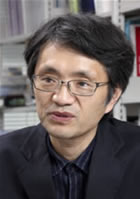2010/09/03
Discovering the intelligence of communication in martial arts
Professor Yoshihiko Nakamura
(Department of Mechano-Informatics)

Professor Nakamura presented the scene in which a humanoid robot quickly behave having great reflexes like athletes.  He studies on communication of humans and robots with the scope that all necessary communication elements are in martial arts.  Human thought process cannot be embedded as it is into a robot.  Thus, as the information processing theory of communication is developed, it is verified in martial arts.
Professor Nakamura approaches a humanoid robot from the perspectives of dynamics and control, aiming to establish dynamics-based information processing of intelligence.¬† Dynamic phenomena with integrated body movements and information processing are the domain of ‚Äúbrain-like information processing‚ÄĚ and the current goal is to develop the dynamics-based system that integrates ‚Äúacquisition of behaviors,‚ÄĚ ‚Äúrecognition,‚ÄĚ and ‚Äúgeneration‚ÄĚ by a robot.¬† How is this approached?
If you carefully observe human movements, there is discontinuity as seen in the motion of joints. Movements are encoded and segmented for a robot to understand, aggregated as a cluster, and multiple clusters are combined so that a robot can infer movement patterns and behave accordingly.  In other words, a robot understands behaviors by observing humans, autonomously makes decisions, and takes actions.  The first step in realizing this is Virtual Fighting in which a robot and a human combat on an equal basis.  A robot does not move based on the scenario (program), it rather understands human intentions and behaviors and tries to respond with gestures and motions that are familiar to humans.  The research does not only focus on passively accumulating behavioral patterns but also on giving a robot many patterns so that it can initiate motions anytime depending on the situation.
A robot is a good example of interdisciplinary research.¬† It is the research ‚Äúto learn about humans‚ÄĚ which encompasses a number of disciplines including mechanics, physics, precision engineering, information processing, biology, neural and brain science.¬† This is the perspective of Professor Nakamura‚Äôs research.

